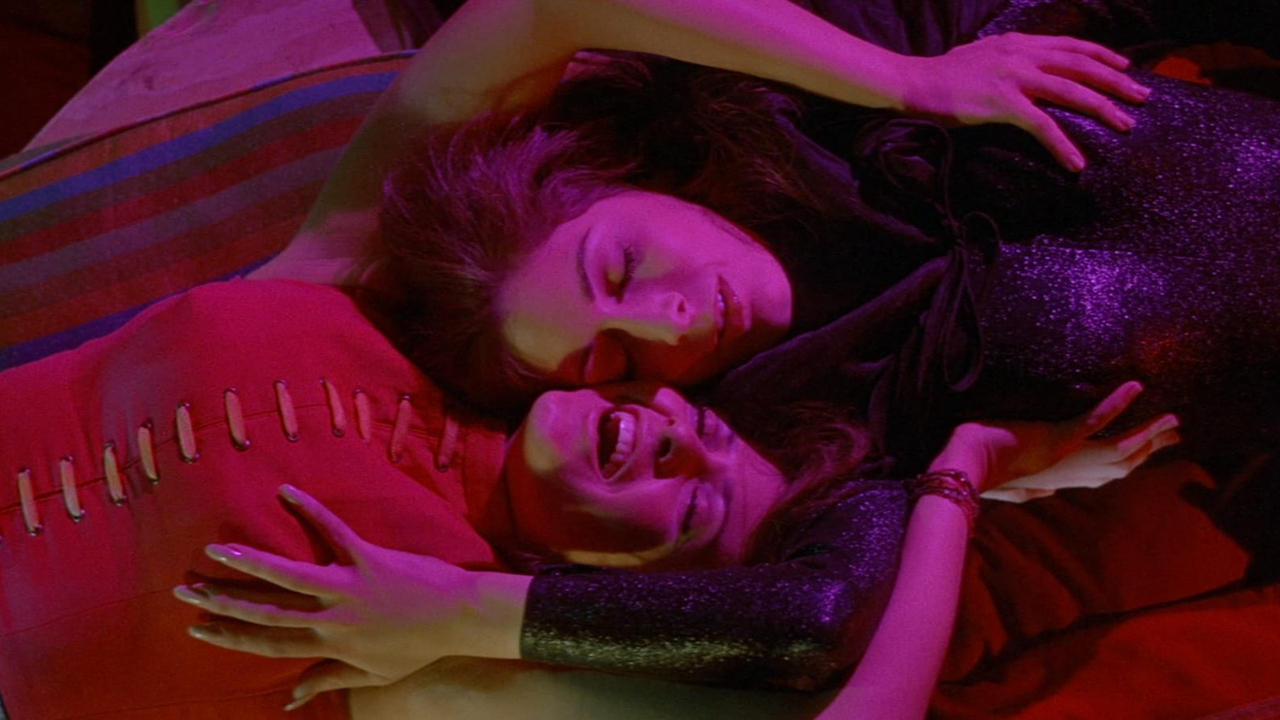



Who payed the critics
I wanted to like it more than I actually did... But much of the humor totally escaped me and I walked out only mildly impressed.
View MoreThe movie's neither hopeful in contrived ways, nor hopeless in different contrived ways. Somehow it manages to be wonderful
View MoreIt’s not bad or unwatchable but despite the amplitude of the spectacle, the end result is underwhelming.
View MoreFantastic encapsulation of the Russ Meyer style with an over the top story, hilarious satire, and great songs! Super fun and tremendous to watch again and again.
View MoreReleased in 1970 and directed by Russ Meyer, "Beyond the Valley of the Dolls" satirizes the previous film, scripted by none other than Roger Ebert. It stars Dolly Read, Cynthia Myers & Marcia McBroom as an all-girl rock band, who move to Los Angeles to make it in the music biz. The group is so well-received that they turn the head of eccentric rock producer Z-Man (John Lazar) who becomes their Svengali-style manager and changes their name to The Carrie Nations, all to the consternation of their small-time manager, who's a Greg Brady lookalike (David Gurian). Can the girls survive the pitfalls that come with the debauched rock lifestyle? The cast is killer, highlighted by the three protagonists, especially the underrated Read. Also worthy of note, besides those cited above, are Michael Blodgett, who's character takes an interest in the singer (Read); Phyllis Davis as her hip aunt; Edy Williams as an oversexed porn star; Erica Gavin who takes a dubious interest in Myers' character; Duncan McLeod as the aunt's sleazy & greedy financial adviser; Charles Napier as her former-beau; Henry Rowland as Z-Man's employee who (I guess) likes to dress-up as a Nazi; and Harrison Page & James Iglehart who vie for the attentions of the foxy drummer (McBroom).The movie telegraphs right out of the gate that it's a joke and not to be taken seriously, like the first film (at least, like they TRIED to do with the first film). The best thing about "Beyond" is that it's the absolute apogee of the late 60s (being shot in '69) and everything that went with it — the overindulgence in drugs, "free" sex, libertine parties, go-go dancing, rock and general debauchedness. There are several noteworthy women, with cutie Read the arguable frontrunner. Also, some of the tunes the band plays are actually good and catchy. All these factors make for a fun, entertaining flick, which explains how it quickly became a cult film.Yet its quality is brought down by needless nudity and tame sex scenes that strapped it with a NC-17 rating and limited its access to the masses, not to mention its general appeal, which could've been easily avoided by wisely trimming down a few scenes. There's also too much fruity twaddle for my tastes and the "story" seems to be just one "wild party" after another, which gets redundant. Still, "Beyond" is the undeniable pinnacle of late 60's flicks, even though it can't be taken seriously for a moment, which is actually fitting.The film runs 109 minutes and was shot in Los Angeles, California.GRADE: B-
View MoreAn all-girl group, the Carrie Nations, comes to Hollywood to make it big. But Kelly (Dolly Read), Casey (Cynthia Meyers) and Pet (Marcia McBroom) are lured into a kaleidoscope of sex, drugs and evil that leads to the ultimate violence in a city of deranged angels.The first time you watch Beyond the Valley of the Dolls, you experience it as a cult cinematic mind trip: a hallucinogenic soft-core porn tour to the tail end of the Swinging Sixties.On another level, it is a clever, funny, subversive. The Carrie Nations are named after a Mother Grundy leader of the moral majority, a woman opposing booze. Z-Man (John Lazar) with his OTT Shakespeare-by-way-of-an-acid-trip dialogue is a fitting tribute to the Bard: in Shakespeare's plays no one was ever what they truly seemed. The horror at the end makes a statement about the notorious Helter Skelter murder of Sharon Tate in its own twisted way.The film is also better structured than the incoherent Valley of the Dolls. It makes good use of montage sequences, set pieces and music. It succeeds, for me, because it never for one single frame takes itself seriously.
View MoreMy favorite scene in this movie is the scene where the "squares" are watching the girl band at a dance, because there are so many young people and pretty girls wearing frilly frocks in confectionery colors with nicely coiffed hair and beautiful smiles, and the music is fun and the color cinematography is bright and clear. But I am aware that what I am actually admiring is the fresh youthfulness and energy of an era that's captured nicely with good color photography, and the casting of pleasing-looking actors, Playboy models with great figures, talented singers, and so forth. People often use words like"camp" and "satire" indiscriminately, applying it to any retro vehicle that's excessive. But this movie has no meaningful referents, containing as it does a lack of dimensional characters or any ideas or emotions about anything it depicts (a campy movie is always passionate about its subject matter, and a satire is clear about what it is mocking), plus it is also staunchly heterosexual in its sensibilities and status-quo about sexuality. So it's not actually camp or satire, it's more just unfocused gleeful nihilism. It's a Russ Meyer world where women contain none of the feminine complexities they contain in life, and where the characters seem less than the actors portraying them. It ends with a "blow up the world and the film and the plot because nothing matters" sort of ending, which for me sort of sums up the attitude of the movie as a whole to its audience and cancels out some of the previous pleasures of its mise en scène. But for those to whom nihilism equals a rollicking good time, this is the perfect cocktail.
View More